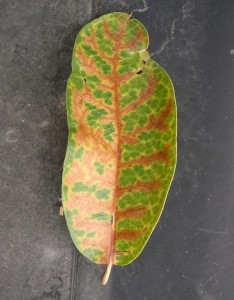If you’ve got freshly cut oaks with unpainted wounds, beware. A fungal fiend could feast on your trees.
There’s not much time left to prune your oak trees this winter, especially if you want to minimize the chance of oak wilt.
Caused by the fungus Bretziella fagacearum, oak wilt is a disease that affects the tree’s ability to absorb water, causing the tree to dehydrate, wither and die in a short period of time. The fungus is carried from tree to tree by a tiny insect that feeds on the sap of freshly cut trees.
Additionally, oak wilt can be transmitted through the interconnected roots of live oaks — so one diseased tree can infect all the other oaks its roots touch.
Experts say certain oak varieties are more susceptible to dying from and transmitting disease than others. Among them are red oaks, which play a big role in the spread of new infections. Fungal mats, the source of oak wilt spores, are only found on infected red oaks. The sweet smell of these mats attracts the insects that pick up the spores and carry the disease to nearby injured trees (those with unpainted wounds).
 Symptoms of oak wilt in evergreen oaks include yellow leaf veins that turn brownish over time. Wood from a tree that has died of the disease should be destroyed. Transporting infected wood can spread oak wilt to new locations. If you suspect that a tree has oak wilt, it’s best to call an expert arborist to help diagnose the problem.
Symptoms of oak wilt in evergreen oaks include yellow leaf veins that turn brownish over time. Wood from a tree that has died of the disease should be destroyed. Transporting infected wood can spread oak wilt to new locations. If you suspect that a tree has oak wilt, it’s best to call an expert arborist to help diagnose the problem.
Prevention is the key to combat the spread of this disease.
That means only pruning oaks in winter or summer — before February 15 or after June 15 — when the beetles that carry the spores of the oak wilt fungus are very few and unlikely to fly.
Most importantly, remember to always paint fresh oak wounds immediately after you prune.


